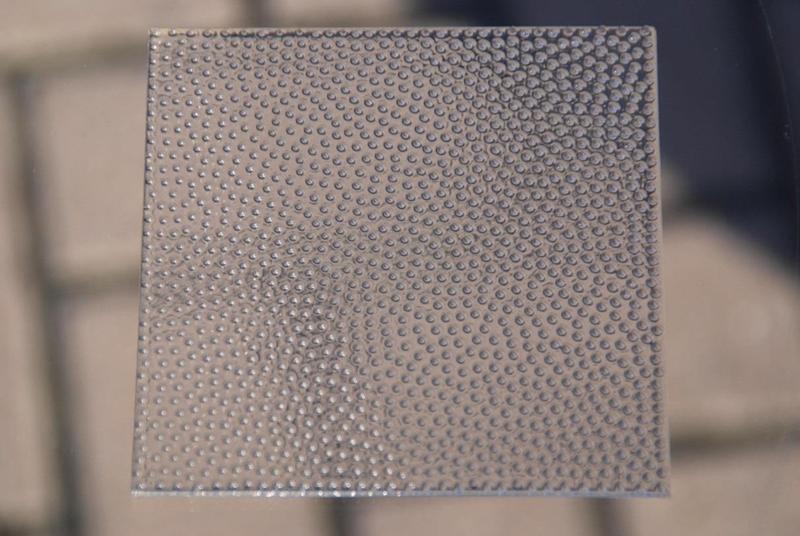 Just last month, Netherlands-based LUXeXcel announced a new partnership with Edmund Optics to bring 3D printed plastic optics to the photonics industry. LUXeXcel‘s announcement then just got the ball rolling, as now they’ve just released news of progress on another front, as they’ve teamed up with a second optics company in another working partnership. Massachusetts-based Lambda Research, which designs optical design and illumination software, including their flagship TracePro software, is now working with LUXeXcel toward the production of custom-textured lens arrays.
Just last month, Netherlands-based LUXeXcel announced a new partnership with Edmund Optics to bring 3D printed plastic optics to the photonics industry. LUXeXcel‘s announcement then just got the ball rolling, as now they’ve just released news of progress on another front, as they’ve teamed up with a second optics company in another working partnership. Massachusetts-based Lambda Research, which designs optical design and illumination software, including their flagship TracePro software, is now working with LUXeXcel toward the production of custom-textured lens arrays.
“LUXeXceL’s printing process and TracePro are complementary for optics designers in their quest to design the best solution for every project, not having to compromise with standard, less optimal, products,” said Richard van de Vrie, president and founder of LUXeXcel. “[This provides] optical designers with full control over the light distribution, ensuring speed and reduction of project costs.”
By bringing these technologies together, the aim is to allow for “mass customization” of plastic-made optical components, including textured lenses, that can be created to exacting specifications.
![]() Their process starts with TracePro software, Lambda Research’s illumination and optical design software, in which optical designers create prototype designs that can be exported as CAD files for 3D printing.
Their process starts with TracePro software, Lambda Research’s illumination and optical design software, in which optical designers create prototype designs that can be exported as CAD files for 3D printing.
“TracePro software simulates the distribution of the light and the luminous intensity,” said Lambda Research’s VP of Sales and Marketing, Michael Gauvin. “This will give designers insight into how the light distrbution of their printed product will look like.”

Custom textured lens array designed using TracePro software printed by LUXeXcel (photo: Lambda Research/LUXeXcel)
A “high-quality, commercially viable” lens array was created to showcase the integrated benefits of the partnership. Using TracePro Texture Optimizer, the design was created to diffuse light across the array due to texture and depth variations. TracePro is able to integrate LUXeXcel materials into its design consideration, so designers can see the qualities of the materials and how they will affect the product’s light output.
Once converted into and exported as a CAD file, LUXeXcel took the lead in 3D printing the pieces. The entire iterative process is shortened to a matter of days, a benefit of additive manufacturing enjoyed through a variety of industries where lowering both costs and lead times are hugely beneficial.
“T
he function of our created lens array is to provide randomized uniform light output with light either propagating through the part or reflecting off the part. The texture applied to the part is specific to take a non-uniform propagating light output and create uniform light,” said Lambda Research’s Gauvin. “This is achieved by varying the texture in such a way that strong light areas are reduced and weak light areas are supplanted by moving light from the strong light areas to the weaker ones.”
This partnership should provide some interesting results through the combination of the companies’ complementary technology offerings. Let us know what you think of LUXeXcel’s ongoing forays into 3D printing partnerships in the optics field in the LUXeXcel and Lambda Research forum thread over at 3DPB.com.
Subscribe to Our Email Newsletter
Stay up-to-date on all the latest news from the 3D printing industry and receive information and offers from third party vendors.
Print Services
Upload your 3D Models and get them printed quickly and efficiently.
You May Also Like
Making Space: Stratasys Global Director of Aerospace & Defense Conrad Smith Discusses the Space Supply Chain Council
Of all the many verticals that have been significant additive manufacturing (AM) adopters, few have been more deeply influenced by the incorporation of AM into their workflows than the space...
EOS in India: AM’s Rising Star
EOS is doubling down on India. With a growing base of aerospace startups, new government policies, and a massive engineering workforce, India is quickly becoming one of the most important...
PostProcess CEO on Why the “Dirty Little Secret” of 3D Printing Can’t Be Ignored Anymore
If you’ve ever peeked behind the scenes of a 3D printing lab, you might have caught a glimpse of the post-processing room; maybe it’s messy, maybe hidden behind a mysterious...
Stratasys & Automation Intelligence Open North American Tooling Center in Flint
Stratasys has opened the North American Stratasys Tooling Center (NASTC) in Flint, Michigan, together with automation integrator and software firm Automation Intelligence. Stratasys wants the new center to help reduce...



































